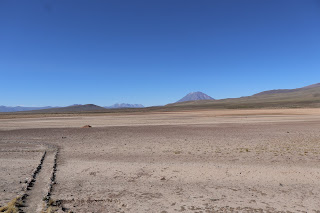Salinas y Aguada Blanca National Reserve is a protected area located in the
regions of Arequipa and Moquegua, Peru.
The landscape features high Andean plateaus dotted by lakes and meadows; and
surrounded by volcanoes like Ubinas, Misti, Pichu Pichu and Chachani in the
southwest and by mounts Chuccura and Huarancante in the north.
Some mammals native to the reserve are: the llama, the alpaca, the vicuña, the
guanaco, the taruca, the vizcacha, the puma, the Andean mountain cat, the
colocolo and the Andean fox.
Among the birds native to the reserve are: the Andean goose, the crested duck,
the Andean flamingo, James's flamingo, the Tamarugo conebill, the silvery
grebe and the giant coot.
Two threatened species of amphibians, Telmatobius arequipensis and
Rhinella spinulosa, inhabit the reserve.
|
Vicuñas in Salinas and Aguada Blanca National Reserve
The vicuña (Lama vicugna) or vicuna is one of the two wild South
American camelids, which live in the high alpine areas of the Andes, the
other being the guanaco, which lives at lower elevations.
-
Vicuñas are relatives of the llama, and are now believed to be the
wild ancestor of domesticated alpacas, which are raised for their
coats.
-
Vicuñas produce small amounts of extremely fine wool, which is very
expensive because the animal can only be shorn every three years and
has to be caught from the wild.
-
When knitted together, the product of the vicuña's wool is very soft
and warm.
-
The Inca valued vicuñas highly for their wool, and it was against the
law for anyone but royalty to wear vicuña garments.
-
Today, the vicuña is the national animal of Peru and appears on the
Peruvian coat of arms.
-
See more at
Vicuña - Wikipedia.
|
|
Panorama of Vicuñas Pampa Cañahuas
Vicuñas live at altitudes of 3,200 to 4,800 m (10,500–15,700 ft).
-
They feed in daytime on the grassy plains of the Andes Mountains, but
spend the nights on the slopes. In these areas, only nutrient-poor,
tough, bunch grasses and Festuca grow.
-
The sun's rays are able to penetrate the thin atmosphere, producing
relatively warm temperatures during the day; however, the temperatures
drop to freezing at night. The vicuña's thick but soft coat is a
special adaptation which traps layers of warm air close to its body,
so it can tolerate freezing temperatures.
|
|
Sign informing us that we are in a vicuña area
|
|
Panorama of the Pillones region
|
|
Vicuña grazing
The behavior of vicuñas is similar to that of the guanacos. They are
very shy animals, and are easily aroused by intruders, due, among other
things, to their extraordinary hearing.
-
Like the guanacos, they frequently lick calcareous stones and rocks,
which are rich in salt, and also drink salt water.
-
Vicuñas are very clean animals, and always deposit their excrement in
the same place.
-
Their diets consist mainly of low grasses which grow in clumps on the
ground.
|
See also
Source
Location
Viewpoint and Church of Yanahuara
Tio Dario Restaurant
Monastery of Santa Catalina de Siena
Basilica Cathedral























